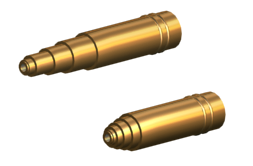You control a joint's resistance to motion, and its tendency to return to its original position, by setting Ease, Damping, and Spring Back options.

Moving telescopes with and without damping
An organic joint, or a worn mechanical joint, moves freely in the middle of its range of motion but moves less freely at the extremes of its range. Use Ease to cause a joint to resist motion as it approaches its From and To limits.
For example, your forearm might move freely in the middle of its range of motion, but it resists movement when you try to squeeze it against your upper arm or extend it all the way out. Ease simulates this effect.
As a joint corrodes, dries out, or is put under a heavy load, it resists motion along its active axes. Damping simulates the natural effect of joint friction or inertia. Enter a value greater than zero in the Damping field to apply resistance over a joint's full range of motion.
As damping increases a joint resists motion and other joints are required to move more. A damping value of 1.0 means there is extreme resistance and a joint will not move on that axis.
For example, a telescope with no damping at all allows each cylinder to move to its maximum limit before the next cylinder moves. If the cylinders have damping values assigned, then each cylinder causes its parent to begin moving before it reaches full extension.
Setting a Joint to Spring Back
When a joint resists motion, it also has a tendency to return toward its at-rest position. You simulate this by setting Spring Back tension in the joints. As the joint moves further from its rest position, an increasingly larger force pulls the joint back, like a spring.
When you set Spring Tension higher, the spring pulls harder as the joint moves farther away from its rest position. Very high settings can turn the joint into a limit, because you can reach the point where the spring is too strong to allow the joint to move any farther.
You set Joint Precedence to control the order in which joint calculations are applied to the kinematic chain. When an IK solution is calculated, the result is dependent on the order of calculation for each joint.
The default joint precedence is suitable for many HD IK solutions. It assumes that joints closest to where a force is applied (the end effector) will move more than joints farther from the force.
Child–>Parent precedence causes joints closest to where a force is applied (the end effector) to move more than joints that are farther away from the force. Like the default precedence, Child->Parent precedence produces a natural result that is suitable for many IK solutions.
Parent->Child precedence causes joints closest to where a force is applied (the end effector) to move less than joints farther away from the force. This is the opposite of Child->Parent precedence. Parent->Child precedence assigns the highest precedence to the base object and the lowest precedence to the end effector.
Some models and animated motions don't fit neatly into a Child->Parent or Parent->Child precedence. In such situations you can manually assign precedence values to any object in the IK chain on a joint-by-joint basis.
The kinematic chain is automatically defined using the object you select as the end effector and working up the hierarchical tree to use the root object as the base of the kinematic chain. Sometimes you might not want the kinematic chain to go all the way to the root of the hierarchy. This is especially true when you are animating multi-limbed or branching structures, such as an octopus or a tree.